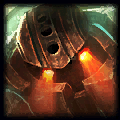

Nautilus vs Seraphine

How to Beat Seraphine as Nautilus
based on 7,303 Nautilus vs Seraphine matchupsHow We Analyze LoL Champion Counters
Nautilus vs Seraphine Matchup Summary
Best Nautilus vs Seraphine Counter Build
Items
Starter Items


Early Items


Core Nautilus Items



Optional Items




Summoner Spells


Skill Order



Runes
















Guide to Countering Seraphine as Nautilus
Tips for Playing as Nautilus against Seraphine
While ganking, consider aiming Dredge Line at nearby terrain and following it up with Riptide for a higher hit rate.
Riptide has a delayed blast timing on activation - you can use this while running away or when enemies are incoming to serve as a deterrent.
Nautilus vs Seraphine Counter Stats


How to Counter Seraphine with Nautilus in LoL
The stat comparisons provided here feature some strategic Nautilus against Seraphine matchup stats that can help us distinguish the differences between the pair. For instance, Nautilus’s KDA ratio ([kills + assists] / deaths) of NaN is better than Seraphine’s ratio of NaN, indicating that Nautilus may be more central to his team's team fighting potential than Seraphine..
Nautilus normally has a slightly smaller longest kill spree than his counter does. Typically, he takes more damage than Seraphine. This is usually reflective of differing health capacities, but it can also indicate that the one champ has less mobility and thus is not able to escape further harm when poked or engaged.
Differences between Nautilus and Seraphine
Damage Types Compared
Champion Playstyles Compared
Who is Better, Nautilus or Seraphine?
Both League champs are great. Both champs have their strengths, weaknesses, and counters. In the game's current meta, Nautilus usually loses when playing against Seraphine, with a 48.3% win rate. Thus, Nautilus makes a bad counter to Seraphine.
While Nautilus does have a lower winrate than Seraphine, when on opposite teams, Nautilus also has a much greater difficulty level that makes him a more complex champ to learn. You still need to be cautious when picking Nautilus into Seraphine.
Moreover, Nautilus also has a good amount of utility and CC, a similar amount to Seraphine. This often makes her just as valuable during team fights, especially when trying to counter champions with a ton of burst damage.
While there isn't a single best champion for every situation in League of Legends, in Nautilus vs Seraphine matchups, Seraphine is the better champion with a lower win rate, more champion depth, and a similar amount of utility to help out your allies during late stage team fights.
Nautilus is a somewhat poor counter to Seraphine. Make sure you focus your actions on keeping up your CS and taking out objectives. If you are able to do that, you should be able to stand on your own as Nautilus against Seraphine.
Other Champion Matchups Against Nautilus
Additional Information for Nautilus Players
How We Calculated Our Nautilus vs Seraphine Build and Stats
Other Useful Resources
Further Insights to Win this Matchup
If you would like to truly master Nautilus in order to counter Seraphine during both the early game and mid / late game phases of League of Legends, you should keep reading to gather a few extra lessons on this matchup. If you pay attention to the build and stats displayed here, you should grow your win rate by a lot and be that much closer to League of Legends pro players.
Nautilus most often picks up less CS compared to Seraphine. Champs who typically don't take much CS usualy don't have to have much CS to be effective, such as supports. These kinds of champions are able to scale properly off of their skills, stats, and first items alone. Yet, champions with large amounts of CS, such as hyper-carries, typically have to have many items to be effective. In either case, try to surpass the values reported on this page to do well.
The ideal items to use in your Nautilus versus Seraphine build include Zeke's Convergence, Thornmail, and Locket of the Iron Solari. When Nautilus bought at least these three items in his build, he performed a lot better versus Seraphine than with many other commonly used item sets. In fact, Nautilus had an average winrate of 48.3% when countering Seraphine with this counter build.
To have the greatest likelihood of beating Seraphine as Nautilus, you should use the Aftershock, Shield Bash, Bone Plating, Unflinching, Biscuit Delivery, and Cosmic Insight runes from the Resolve and Inspiration rune sets. Out of all the rune combinations players used for Nautilus vs Seraphine counters, this combination of runes yielded the best win rate. Notably, these runes provided a 48.3% winrate overall.
By default, tips, stats, and builds on how to beat Seraphine as Nautilus are shown for all ranked divisions combined. To scope the stats and builds to an individual player tier, you may use the selection menu located above.




































